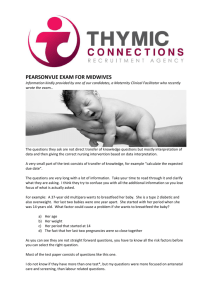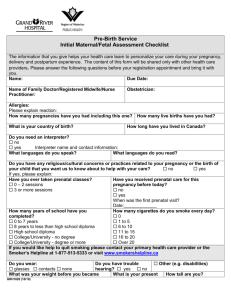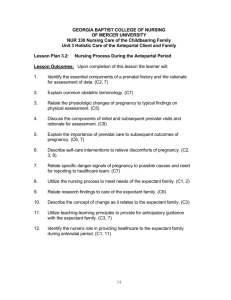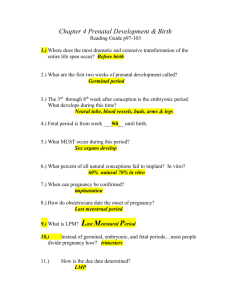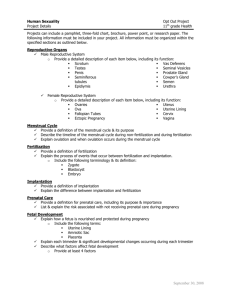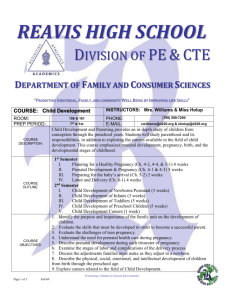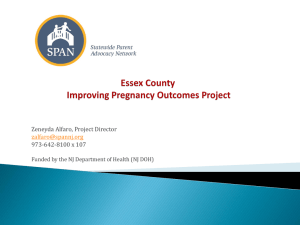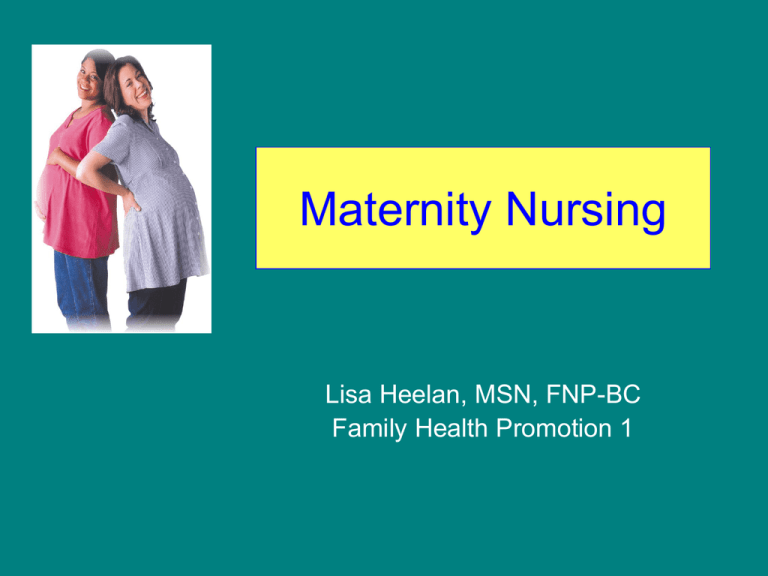
Maternity Nursing
Lisa Heelan, MSN, FNP-BC
Family Health Promotion 1
Learning Objectives
• Evaluate contemporary issues and trends in
maternity nursing
• Examine the Healthy People 2010 goals related
to maternal and newborn care & outcomes
• Describe the main characteristics of
contemporary family forms
• Be knowledgeable in the main components of
what is needed in obtaining a family assessment
• Relate the role of culture in caring for
childbearing families
• Discuss cultural competence in relation to one’s
own nursing practice
• List the components of prenatal care
• Interpret the role & benefits of a doula
Birth in America
• 1900: 95% of all
births took place at
home
• 1939: 50% of all
births at home
• 1955: 95% of all
births in the hospital
Wolf, 2009
Childbirth is the #1 reason for all
hospitalizations
100 babies born in Pennsylvania
* 12 will be born preterm
* 3 will die before reaching their
first birthday
* 4 will be born with a birth defects
* 8 will be born low birth weight
March of Dimes
Report Card
• http://marchofdimes.com/aboutus/49267_6
2035.asp
http://www.healthypeople.gov/document/html/vo
lume2/16mich.htm#_Toc494699663
What to expect during a prenatal
visit….
http://www.youtube.com/watch?v=qZqGZLw
DfdE
Listening to Mother’s Survey
http://www.childbirthconnection.org/article.as
p?ck=10396
Prenatal Care
Risk
Assessment
Treatment for
medical conditions
or risk reduction
Education
Each component can contribute to
reductions in perinatal illness, disability and
death by identifying and mitigating potential
complications
Frequency of
Prenatal Visits
Every 4 weeks until 28 weeks gestation
Every 2 weeks until 36 weeks gestation
Weekly until delivery
Antepartal Nursing
Interventions
• Being knowledgeable in the normal
changes of pregnancy
• Instructing in signs & symptoms that
indicate a problem may be developing
• Providing appropriate information for self
care measures
• Referring when necessary
Nursing in a Home
Care Setting
• Can be used for women who have
difficulty in accessing the healthcare
system
• Most often used for women with prenatal
complications that can be managed
without hospitalization.
Attitude
about pregnancy
Exercise
Rest
Smoking
Traveling
First Trimester
Topics
Danger signs
of spontaneous
abortion
Fetal growth
development
Early pregnancy
classes
Employment
Infants tend to
have lower birth
weights
Infants have a
higher incidence
of preterm birth
The Faces of Fetal Alcohol Syndrome
Growth Retardation
Facial Anomalies
Major Cause of
mental retardation
Even moderate alcohol
intake is contraindicated
• Increased incidence of lowered birth
weight
• Some neurologic effects such as Attention
Deficit Disorder
No Safe level of drinking during
pregnancy has been identified
• Live Viruses (like
rubella) should not be
given to pregnant
women
• Vaccines using killed
viruses may be used
Exercise during pregnancy
• 30 minutes daily and
stop when fatigued
• No balance activities
• No exercising in supine
position
• Pulse rates < 140/min
Nursing Pearls of Wisdom
At each prenatal visit, focus your teaching
on changes or possible discomforts the
woman might encounter during the coming
month and the next trimester.
The importance of support during
labor---having a doula
http://www.youtube.com/watch?v=16uFf02N
Yb4
http://www.youtube.com/watch?v=HfOBVPZ
g94Y
We Are Family
Types of Families
Nuclear
Married-parent
Childless
Extended
Cohabiting parent
Single-Parent
Married blended
Gay & Lesbian
The primary institution in society that preserves & transmits
culture.
What basic information should be
included in a Family Assessment?
Family Assessment
• Name, age, sex and family relationship
of all people residing in the household
• Family type, structure roles and values
• Cultural associations
• Religious affiliations
• Language
• Support network
Friedman Family Assessment
Model
•
•
•
•
•
•
Identifying data
History of family
Environmental data
Family structure
Family functions
Family stress &
coping
Culture is not just
something the client
possesses; it is
something that all
humans possess.
It is learned….
Ethnocentrism
Conviction that the values and beliefs of one’s
own cultural group are the best ones or the only
acceptable ones
Are there cultural influences
on childbearing and rearing?
Beliefs regarding pregnancy
Amish
AfricanAmercan
Appalachian
Chinese
Mexican
Arab
Refers to behaviors or
things that are avoided
What is avoided in
your family?
“Ask not what disease
the person has, but
rather, what person the
disease has.”
Develop cultural competence by becoming
knowledgeable about the cultural practices
of local groups where you work and live.
Cultural Humility: Lifelong process of self
reflection and awareness with a respectful attitude
toward diverse points of view.
It’s all about relationships…..
And Respect…which comes full
circle
Questions to ask….
What do you think you
should do to remain
healthy during pregnancy?
What healing methods
have you tried?
What do you think
will help?
Who do you want with
you during your labor?
How will family
members participate in
your pregnancy,
childbirth & parenting?
What do you and your
family expect from the
nurses caring for you?
• L= Listen
• E=Explain
• A=Acknowledge
• R=Recommend
• N=Negotiate
References
• Center for Disease Control, US Department of Health
and Human Services. (2010). Healthy People 2010,
2nd edition. 16-62. Retrieved from
http://www.healthypeople.gov/Document/HTML/Volume
2/16MICH.htm#Toc494699662
• Declercq, E., Sakala, C., Corry, M., & Applebaum, S.
(2006). Listening to mothers 11: Report of the
second national US Survey of women’s
childbearing experiences. Retrieved from
http://www.childbirthconnection.org/pdf.asp?PDFDownload
=LTM11_report
• Epstein, R. (2010). Get me out: A history of childbirth.
New York: W.W. Norton & Company
• Fadiman, A. (1997). The spirit catches you and you
fall down: A Hmong child, her American doctors &
the collision of the cultures. New York: Farrar,
Straus & Giroux
• Lowdermilk, D. & Perry, S. (2007). Maternity & women’s
health care. (9th edition). St. Louis: Mosby Elsevier
• Wolf, J. (2009). Deliver me from pain.
Baltimore: The John Hopkins University Press

